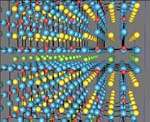The mechanism of high-temperature superconductivity is one of the main unsolved problems in condensed-matter physics. A. V. Boris et al. from Max-Planck-Institut, Germany present their study of YBa2Cu3O6.9 in this week Science issue (Science, Vol 304, Issue 5671, 708-710 , 30 April 2004).
YBa2Cu3O6.9 is a high-temperature superconductor with superconducting transition temperature of 92.7 Kelvin.
The mechanism of high-temperature superconductivity is one of the main unsolved problems in condensed-matter physics. An influential class of theories predicts that high-temperature superconductivity arises from an unconventional pairing mechanism driven by a reduction of the kinetic energy of the charge carriers in the superconducting state. This contrasts with the conventional Bardeen-Cooper-Schrieffer model, where correlations of the charge carriers below the superconducting transition temperature, Tc, bring about an increase in their kinetic energy, which is overcompensated for by a reduction of the potential energy due to the phonon-mediated attraction.
Precise optical data may thus enable one to address the issue of a kinetic energy–driven high-temperature superconductivity pairing mechanism.
In this research work YBa2Cu3O6.9 was studied with wide-band (0.01– to 5.6–electron volt) spectroscopic ellipsometry.
A superconductivity-induced transfer of the spectral weight involving a high-energy scale in excess of 1 electron volt was observed. Correspondingly, the charge carrier spectral weight was shown to decrease in the superconducting state.
The ellipsometric data also provided detailed information about the evolution of the optical self-energy in the normal and superconducting states.
























